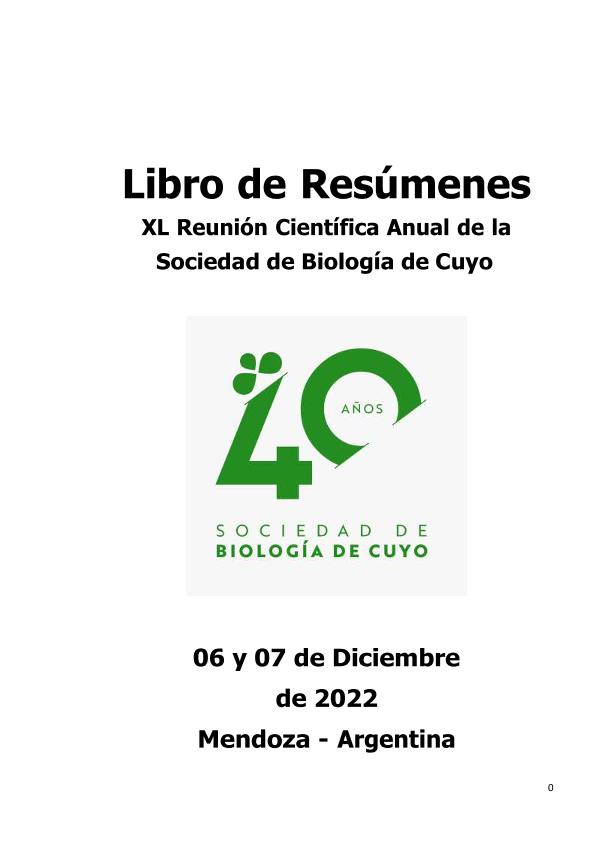Mostrar el registro sencillo del ítem
dc.contributor.author
Dominguez, Facundo Gabriel

dc.contributor.author
Pacheco, Mariana Soledad

dc.contributor.author
Torres, Mariela Analía

dc.contributor.author
Nieto Peñalver, Carlos Gabriel

dc.contributor.author
Pajot, Hipolito Fernando

dc.date.available
2023-09-25T15:15:23Z
dc.date.issued
2022
dc.identifier.citation
Towards the design of stable and effective dye-decolorizing consortia of edible fungi; XL Reunión Científica Anual de la Sociedad de Biología de Cuyo; Mendoza; Argentina; 2022; 1-2
dc.identifier.issn
0327-9545
dc.identifier.uri
http://hdl.handle.net/11336/212932
dc.description.abstract
Synthetic dyes are used in textile industries due to their advantages over natural dyes. However, textile effluents cause irreparable damageto water bodies because of the proper toxicity of textile dyes or by reducing the penetration of visible light leading to the eutrophicationrivers and lakes. Aerobic biodecoloration is an interesting treatment alternative for these effluents. However, no microorganism is capableof degrading all existing dyes, making the use of microbial consortia mandatory. Wood White Rot fungi produce enzymes such as Laccase,Manganese Peroxidase or Lignin Peroxidase that have been widely used for the degradation of textile dyes. The objective of this work wasthe selection of compatible edible fungi for the formation of consortiums capable of degrading different colorants. For this, we selected tenPleurotus, Psilocybe, Ganoderma and Lentinula strains. Fungi were maintained in Petri dishes with 20 mL of solid YM medium (glucose:1%, soy peptone: 0.5%, yeast extract: 0.3%, malt extract: 0.3%, agar: 1.8%), incubated at 25°C. Media were inoculated with 5 mm diameterplugs obtained from growths in solid YM medium, preincubated for 7 days at 25°C. The laccase production of the different fungi wasevaluated in solid media using eight substrates: 2,2-Azino-bis(3-ethylbenzothiazoline-6-sulfonic acid (ABTS), catechol, 2,6-dimethoxyphenol, 1-naphthol, benzidine, syringaldazine, 3,4-dimethoxybenzylalcohol, and guaiacol. Assays in which oxidized substratesproduced haloes of different colors around the wells were considered positive. To carry out the compatibility tests, the ten strains wereconfronted with each other on different plates with YM solid medium in duplicate and incubated for 7 days at 25°C. Four modes ofinteraction were observed: inhibition haloes, zone with a dark line (in the contact of one strain with the other the line is produced),overgrowth (invasion of one strain on the other) and growth without inhibition. For the evaluation of the bleaching capacity of each strain,four industrial textile dyes were used: Black Vilmafix® B-V, Blue Vimafix® RR-BB, Red Vilmafix® 7B-HE and Orange Procion® HER,which were seeded in four wells made in the plates of each strain forming halos of each color. After 24 hours of incubation at 25°C,different levels of degradation were observed around the haloes depending on the structure of the dye. The results show that the testedfungi could be employed in the design of effective dye decolorizing consortia.
dc.format
application/pdf
dc.language.iso
eng
dc.publisher
Tech Science Press

dc.rights
info:eu-repo/semantics/openAccess
dc.rights.uri
https://creativecommons.org/licenses/by-nc-sa/2.5/ar/
dc.subject
EDIBLE FUNGI
dc.subject
CONSORTIA
dc.subject
BIOREMEDIATION
dc.subject.classification
Otras Biotecnología del Medio Ambiente

dc.subject.classification
Biotecnología del Medio Ambiente

dc.subject.classification
INGENIERÍAS Y TECNOLOGÍAS

dc.title
Towards the design of stable and effective dye-decolorizing consortia of edible fungi
dc.type
info:eu-repo/semantics/publishedVersion
dc.type
info:eu-repo/semantics/conferenceObject
dc.type
info:ar-repo/semantics/documento de conferencia
dc.date.updated
2023-09-15T11:31:11Z
dc.journal.pagination
1-2
dc.journal.pais
Argentina

dc.journal.ciudad
Ciudad Autónoma de Buenos Aires
dc.description.fil
Fil: Dominguez, Facundo Gabriel. Consejo Nacional de Investigaciones Científicas y Técnicas. Centro Científico Tecnológico Conicet - Tucumán. Planta Piloto de Procesos Industriales Microbiológicos; Argentina
dc.description.fil
Fil: Pacheco, Mariana Soledad. Consejo Nacional de Investigaciones Científicas y Técnicas. Centro Científico Tecnológico Conicet - Tucumán. Planta Piloto de Procesos Industriales Microbiológicos; Argentina
dc.description.fil
Fil: Torres, Mariela Analía. Consejo Nacional de Investigaciones Científicas y Técnicas. Centro Científico Tecnológico Conicet - Tucumán. Planta Piloto de Procesos Industriales Microbiológicos; Argentina
dc.description.fil
Fil: Nieto Peñalver, Carlos Gabriel. Consejo Nacional de Investigaciones Científicas y Técnicas. Centro Científico Tecnológico Conicet - Tucumán. Planta Piloto de Procesos Industriales Microbiológicos; Argentina
dc.description.fil
Fil: Pajot, Hipolito Fernando. Consejo Nacional de Investigaciones Científicas y Técnicas. Centro Científico Tecnológico Conicet - Tucumán. Planta Piloto de Procesos Industriales Microbiológicos; Argentina
dc.relation.alternativeid
info:eu-repo/semantics/altIdentifier/url/https://sbcuyo.org.ar/wp-content/uploads/2022/12/libro-resumenes-2022.pdf
dc.conicet.rol
Autor

dc.conicet.rol
Autor

dc.conicet.rol
Autor

dc.conicet.rol
Autor

dc.conicet.rol
Autor

dc.coverage
Internacional
dc.type.subtype
Reunión
dc.description.nombreEvento
XL Reunión Científica Anual de la Sociedad de Biología de Cuyo
dc.date.evento
2022-12-05
dc.description.ciudadEvento
Mendoza
dc.description.paisEvento
Argentina

dc.type.publicacion
Journal
dc.description.institucionOrganizadora
Sociedad de Biología de Cuyo
dc.source.revista
Biocell

dc.date.eventoHasta
2022-12-07
dc.type
Reunión
Archivos asociados
